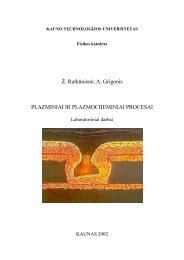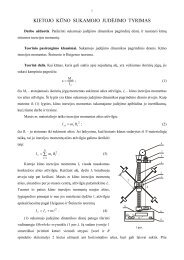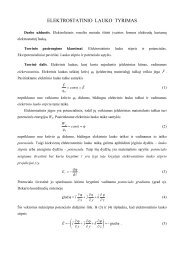PROCEEDINGS OF THE 7 INTERNATIONAL ... - Fizika
PROCEEDINGS OF THE 7 INTERNATIONAL ... - Fizika
PROCEEDINGS OF THE 7 INTERNATIONAL ... - Fizika
Create successful ePaper yourself
Turn your PDF publications into a flip-book with our unique Google optimized e-Paper software.
D. Bernatavičius et al. / Medical Physics in the Baltic States 7 (2009) 102 - 105<br />
assess whether radiofrequency radiation exposure from<br />
mobile phones is associated with tumour risk,<br />
specifically, risk of glioma, meningioma, acoustic<br />
neuroma and parotid gland tumours. [2]<br />
Despite the fact that the study has been started in year<br />
2004 collective INTERPHONE results are not<br />
published yet. Researches claim that using a mobile<br />
phone for ≥10 years approximately doubles the risk of<br />
being diagnosed with a brain tumour on the same side<br />
of the head as that preferred for cell phone use. [4]<br />
2. Experimental<br />
Measurements of field strength were performed using<br />
portable wide band electric field meter Chauvin<br />
Arnoux C.A 43. (Table 2).<br />
Table 2. Main specifications of field meter<br />
Bandwidth Electric field<br />
100 kHz 0,1 V/m<br />
to 2,5 GHz to 200 V/m<br />
Measurement’s location and distances from the<br />
transmitter tower were identified using GPS navigation<br />
system Acme NS-351. Mobile phone Nokia 6500c was<br />
used in all measurements.<br />
Measurements were performed for four mobile phone<br />
modes in each location, indicated in Fig.1. These<br />
modes were: 1.swich on; 2.dialling and calling;<br />
3.ringing and answering; 4.sending SMS. Considering<br />
the fact that there is a natural background of<br />
electromagnetic radiation, it was not necessary to<br />
measure electric field for a long time. The first and the<br />
fourth modes required up to 10 seconds for one<br />
measurement, however the second ant the third modes<br />
required up to 30 seconds for one measurement.<br />
Fig. 1. Locations of measurement points<br />
All measurements were performed holding the phone at<br />
a distance of ~20 cm to antenna of field meter. This<br />
distance is about the same as diameter of human head.<br />
Locations of measurements were selected along the<br />
road 5 to 10 meters outside from the road and were<br />
103<br />
marked on the map. Locations outside of the road were<br />
selected to ensure independency of the experiment on<br />
the traffic (It was possible that vehicles are equipped<br />
with radio transmitters).<br />
3. Results<br />
Collected data was grouped and analysed. Only mostly<br />
typical data for different locations are presented in this<br />
paper.<br />
Only small variations from 1 V/m to 2 V/m. of the<br />
background electric field were found during the<br />
investigation. Do to this reason, no compensation<br />
measures were undertaken.<br />
It is easily seen in Fig.2 that the field strength increases<br />
during the first second to maximum and then drops<br />
down step by step. The curves for switch on and<br />
sending SMS are approximately the same, but the<br />
curve representing calling-mode is different: it drops<br />
down when the conversation starts, but remains higher<br />
than the background level until the end of conversation.<br />
E, V/m<br />
18<br />
16<br />
14<br />
12<br />
10<br />
8<br />
6<br />
4<br />
2<br />
0<br />
Switching on<br />
Calling<br />
Sending SMS<br />
0 5 10 15 20 25<br />
t, s<br />
Fig. 2. Changes of electric field strength for different<br />
modes of phone operation<br />
t, s<br />
30<br />
25<br />
20<br />
15<br />
10<br />
5<br />
0<br />
0 5 10 15<br />
d, km<br />
Fig. 3. Time span which is needed for drop down of the<br />
electric field strength in call mode of phone








